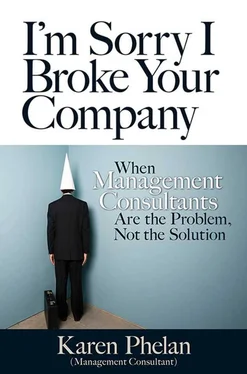Karen Phelan - I'm Sorry I broke Your Company
Здесь есть возможность читать онлайн «Karen Phelan - I'm Sorry I broke Your Company» весь текст электронной книги совершенно бесплатно (целиком полную версию без сокращений). В некоторых случаях можно слушать аудио, скачать через торрент в формате fb2 и присутствует краткое содержание. Город: San Francisco, Год выпуска: 2013, ISBN: 2013, Издательство: Berrett-Koehler Publishers, Жанр: management, popular_business, на английском языке. Описание произведения, (предисловие) а так же отзывы посетителей доступны на портале библиотеки ЛибКат.
- Название:I'm Sorry I broke Your Company
- Автор:
- Издательство:Berrett-Koehler Publishers
- Жанр:
- Год:2013
- Город:San Francisco
- ISBN:978-1-60994-740-8; 978-1-60994-741-5
- Рейтинг книги:3 / 5. Голосов: 1
-
Избранное:Добавить в избранное
- Отзывы:
-
Ваша оценка:
- 60
- 1
- 2
- 3
- 4
- 5
I'm Sorry I broke Your Company: краткое содержание, описание и аннотация
Предлагаем к чтению аннотацию, описание, краткое содержание или предисловие (зависит от того, что написал сам автор книги «I'm Sorry I broke Your Company»). Если вы не нашли необходимую информацию о книге — напишите в комментариях, мы постараемся отыскать её.
I'm Sorry I broke Your Company — читать онлайн бесплатно полную книгу (весь текст) целиком
Ниже представлен текст книги, разбитый по страницам. Система сохранения места последней прочитанной страницы, позволяет с удобством читать онлайн бесплатно книгу «I'm Sorry I broke Your Company», без необходимости каждый раз заново искать на чём Вы остановились. Поставьте закладку, и сможете в любой момент перейти на страницу, на которой закончили чтение.
Интервал:
Закладка:
Of the whole alphabet soup of management methodologies, from competitive strategy to competency development, if I had to choose just one that has done the most damage to companies and their employees’ lives, the modern performance management system is the winner. In It's current state this system is an automated tool that cascades goals and measures into an employee appraisal and that results in an overall employee rating tied to incentive compensation. With the input of various employee parameters and the click of a few links, an employee’s history can be boiled down to a few numbers and her future career with the company ordained. I can’t really trace the origins of this system to a book or a method. It seems to have evolved from the management-by-objectives movement that tied compensation to goal achievement. Then someone added competencies and development planning, and the whole thing got automated.
My first exposure to management by objectives was in the early ’90s when I was consulting on a business transformation project that involved both strategy and process work. Although we were already accustomed to creating strategic objectives with targets and breaking those down into individual performance metrics, this was the first project in which we would tie these specifically into compensation, which we called «pay-for-performance.» (I apologize for all the jargon, but this particular field is rife with jargon.) This was also the first time we would base all our work on the balanced scorecard. Fortunately for the company, the software to do this automatically had yet to be developed, so this particular system was paper based and applied only to the top levels of management.
When the HR consulting team explained how they were creating a compensation system based on target achievement, I was captivated. The compensation piece was what was missing from my other projects, and this was the linchpin that ensured the whole organization did as it was supposed to do. This way, clients had to implement our recommendations; otherwise, they wouldn’t get their bonuses. It was perfect! Plus, it was great for consulting firms. Strategy consultants could bring in their other arm, operations consultants, to develop the metrics, the targets, and the collection and reporting processes while HR consulting teams could design the compensation systems, goal development, and performance evaluation processes. Then the IT consultants could automate the whole thing. Over the next decade, I observed the growth of performance management systems from big players like PeopleSoft and SAP to specialized companies like Success Factors and Halogen and the consulting firms that could help implement them. Everyone I know who works in a large company is subject to some version of a performance management system.
In 2000, I left consulting and joined a division of a Fortune 100 company that was acquired by another in 2007. I got to experience firsthand all the havoc we consultants had been wreaking for years with this system. Performance management at both places was an automated process that consumed the last six weeks of every year. This is work that does not contribute to developing new products or services or helping customers. Yet every year, I spent a good part of November and all of December writing up lengthy reviews, reviewing and approving others'reviews, attending several daylong meetings to haggle over employee ratings, ranking them, identifying high performers, and then having to inform direct reports of their ultimate rating — the number spit out by the system based on their weighted goal achievement, their mastery of leadership competencies, and a comparison with their peers. What started out as a way to implement strategy turned into a system that rates, labels, and tracks employees the same as if they were inventory. No wonder it was called «human asset management.» It is!
An elegant methodology that theoretically would eliminate nonstrategic work and ensure an aligned and motivated workforce ended up in practice to have the opposite effect. This model is a sham in so many ways that It's difficult to know where to start enumerating It's flaws. Even if we pretend that the assumptions upon which it is based are true — people are motivated only by money, employees improve their performance after being judged and graded by a superior, the whole system is fair and objective, and no one games it for his benefit — the sheer amount of effort, time, and costs involved in implementing, administering, and maintaining such a system is enough of an argument against it.
Lets start with what's involved in implementing this type of compensation system, assuming that It's done with every effort to be fair across the company. Typically, the first step is to determine the salary increases, bonuses, stock options, and stock grants by job and performance level. (Or better yet, the first step is to hire a consulting firm to do this for you.) For instance, under a new reward system, a manager performing at a satisfactory level would get a certain percentage of bonus and salary increase and, perhaps, a package of stock or stock options. That sounds easy enough, but it assumes that the company has standard job levels across all functions. In my experience, a manager in one department is very different from a manager in another and even more so if the company has more than one line of business. If the company has grown as the result of mergers or acquisitions — and seriously, what company hasn't — then job levels are probably really inconsistent.
The company therefore needs to implement standard job levels company-wide or at least group the current levels into a set of standards. This is the only way to ensure fairness. Anyone who has experienced standardizing titles and job levels knows that this is a highly emotionally charged and political process. Slotting every employee into a level is a huge undertaking, and It's aftermath is a vast swath of disgruntled employees. A senior manager doesn't enjoy being demoted to a manager (it rarely goes the other way), nor does an associate director like finding out her job level is the same as a senior managers. All those years of clawing your way up that extra rung of the corporate ladder vanish with a stroke of the delete button.
The next step is to standardize the performance appraisal forms and ratings. Again, if the company has silos or has grown through acquisitions, a variety of forms and scales are likely in use. Some departments will want a 1 to 10 scale while others will want 1 to 5. It takes another company-wide effort to agree on one system and method, but with some cajoling and compromise, this can be done in a couple of months.
The third step is to develop a simple process governing when goals need to be written, how goals will trickle down from the corporate goals, when appraisals need to be completed, and when rewards will be distributed. And the last step is to communicate the new process, calendar, and form to all employees and offer training if needed.
However, after a paper-based system is implemented, a few wrinkles appear:
• Not all goals are created equal. Some people have a knack for writing easily achievable goals. Other goals cant be readily quantified or measured for achievement. Plus, managers' expectations of their direct reports vary widely. A standard method of writing goals is needed.
• Performance is very subjective. What one person judges as «meets expectations,» another person judges as «exceeds expectations.» This also calls for some standardization.
• Developing goals at the beginning of the year to be rated on at the end does not allow enough flexibility to respond to changing business conditions. People need the ability to change goals during the year, but changes would have to be subject to approval or else people would constantly update their goals to what they have already done, defeating the whole purpose of setting goals.
Читать дальшеИнтервал:
Закладка:
Похожие книги на «I'm Sorry I broke Your Company»
Представляем Вашему вниманию похожие книги на «I'm Sorry I broke Your Company» списком для выбора. Мы отобрали схожую по названию и смыслу литературу в надежде предоставить читателям больше вариантов отыскать новые, интересные, ещё непрочитанные произведения.
Обсуждение, отзывы о книге «I'm Sorry I broke Your Company» и просто собственные мнения читателей. Оставьте ваши комментарии, напишите, что Вы думаете о произведении, его смысле или главных героях. Укажите что конкретно понравилось, а что нет, и почему Вы так считаете.












